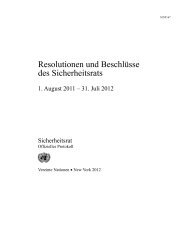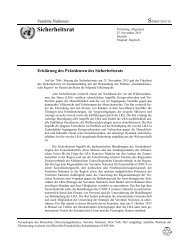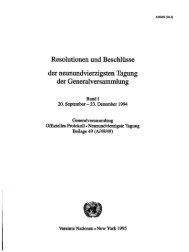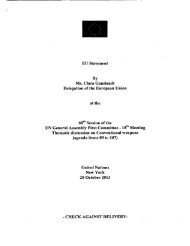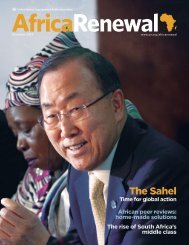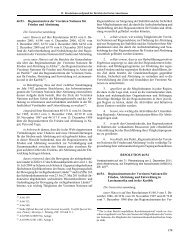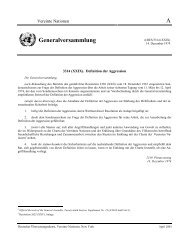Prevention and Response to Sexual Exploitation & Abuse in Liberia
Prevention and Response to Sexual Exploitation & Abuse in Liberia
Prevention and Response to Sexual Exploitation & Abuse in Liberia
Create successful ePaper yourself
Turn your PDF publications into a flip-book with our unique Google optimized e-Paper software.
where implementation of the National GBV Plan of<br />
Action (see below) is set as a priority. Address<strong>in</strong>g<br />
sexual exploitation <strong>and</strong> abuse – a form of SGBVtakes<br />
place with<strong>in</strong> this context.<br />
• National Plan of Action for GBV (POA). Launched<br />
on 30 November, 2006, the POA is the result of multilevel<br />
consultations between GOL, the United Nations<br />
system, local <strong>and</strong> <strong>in</strong>ternational NGOs, <strong>and</strong> local<br />
communities. The POA outl<strong>in</strong>es strategies for the<br />
prevention of SGBV <strong>and</strong> the care of survivors us<strong>in</strong>g<br />
a holistic <strong>and</strong> multi-sec<strong>to</strong>ral approach across 5 pillars:<br />
Health, Psychosocial, Legal, Security/Protection <strong>and</strong><br />
Coord<strong>in</strong>ation.<br />
• National Plan of Action for Women 2008-2011.<br />
In May 2008, a National Women’s Conference was<br />
organized by the M<strong>in</strong>istry of Gender <strong>and</strong> Development<br />
with support from the United Nations <strong>and</strong> other<br />
partners as a forum for over 350 <strong>Liberia</strong>n women<br />
<strong>to</strong> discuss the issues affect<strong>in</strong>g their lives <strong>and</strong> <strong>to</strong><br />
identify key strategies <strong>to</strong> address them. The outcome<br />
document advances protection <strong>and</strong> response <strong>to</strong><br />
SEA as one of three major areas for government<br />
programm<strong>in</strong>g for the next three years.<br />
In order <strong>to</strong> implement the commitments described<br />
above, GOL has developed several response<br />
structures <strong>in</strong>clud<strong>in</strong>g:<br />
• National GBV Task Force. Established <strong>to</strong> implement<br />
the National GBV POA, the Task Force is chaired<br />
by the M<strong>in</strong>istry of Gender <strong>and</strong> Development, <strong>and</strong><br />
comprises all stakeholders: national <strong>and</strong> <strong>in</strong>ternational<br />
NGOs, UN agencies, CBOs <strong>and</strong> the M<strong>in</strong>istry of Health<br />
<strong>and</strong> Social Welfare, the M<strong>in</strong>istry of Justice <strong>and</strong> the<br />
M<strong>in</strong>istry of Information. It is a forum for priority sett<strong>in</strong>g,<br />
<strong>in</strong>formation shar<strong>in</strong>g, <strong>and</strong> coord<strong>in</strong>ation around GBV<br />
<strong>and</strong> SEA. The Task Force is divided <strong>in</strong><strong>to</strong> two pillars.<br />
The Health <strong>and</strong> Psychosocial Pillar chaired by the<br />
M<strong>in</strong>istry of Health <strong>and</strong> Social Welfare, <strong>and</strong> the Legal,<br />
Security <strong>and</strong> Protection Pillar chaired by the M<strong>in</strong>istry<br />
of Justice.<br />
• County Gender Coord<strong>in</strong>a<strong>to</strong>rs. Coord<strong>in</strong>a<strong>to</strong>rs<br />
represent the M<strong>in</strong>istry of Gender <strong>and</strong> Development at<br />
the county level <strong>and</strong> have a strong report<strong>in</strong>g m<strong>and</strong>ate<br />
relat<strong>in</strong>g <strong>to</strong> protection issues <strong>in</strong>clud<strong>in</strong>g GBV <strong>and</strong> SEA.<br />
They are also responsible for build<strong>in</strong>g alliances among<br />
women <strong>and</strong> children organizations <strong>and</strong> networks,<br />
ma<strong>in</strong>stream<strong>in</strong>g gender <strong>and</strong> protection <strong>in</strong> programs<br />
<strong>and</strong> plans of the county authority <strong>and</strong> support<strong>in</strong>g<br />
coord<strong>in</strong>ation of Protection Core Groups at the county<br />
level. The county gender coord<strong>in</strong>a<strong>to</strong>rs chair the GBV<br />
Task Force meet<strong>in</strong>gs <strong>in</strong> the counties <strong>and</strong> are therefore<br />
the ma<strong>in</strong> l<strong>in</strong>k on coord<strong>in</strong>at<strong>in</strong>g SEA activities at county<br />
level.<br />
• GBV Unit. Established <strong>in</strong> the M<strong>in</strong>istry of Gender, the<br />
GBV Unit is responsible <strong>to</strong> collect <strong>and</strong> analyze data,<br />
share <strong>in</strong>formation, coord<strong>in</strong>ate activities <strong>and</strong> direct<br />
policy <strong>in</strong>terventions relat<strong>in</strong>g <strong>to</strong> the implementation of<br />
the POA.<br />
• Crim<strong>in</strong>al Court D. To prosecute sexual offence cases,<br />
staff of this dedicated Court now receive specialized<br />
tra<strong>in</strong><strong>in</strong>g. There are currently two full-time judges<br />
2<br />
assigned <strong>to</strong> the court. The court will have state-ofthe-art<br />
audio/visual equipment <strong>to</strong> ensure anonymity<br />
of victims <strong>and</strong> witnesses <strong>in</strong> l<strong>in</strong>e with <strong>in</strong>ternational<br />
st<strong>and</strong>ards.<br />
• GBV Prosecution Unit <strong>in</strong> the MOJ. This unit will<br />
enhance the Government’s ability <strong>to</strong> prosecute GBV<br />
cases. By 2009, part of the unit will be mobile <strong>to</strong> reach<br />
cases outside Monrovia.<br />
• Women <strong>and</strong> Children’s Protection Section of<br />
<strong>Liberia</strong>n National Police. This structure is now<br />
present <strong>in</strong> 13 of the 15 counties, with national<br />
coverage expected <strong>in</strong> the near future. The officers<br />
have been tra<strong>in</strong>ed <strong>to</strong> <strong>in</strong>vestigate cases, refer survivors<br />
<strong>and</strong> charge perpetra<strong>to</strong>rs <strong>in</strong> a respectful <strong>and</strong> effective<br />
manner.<br />
1.3 Humanitarian <strong>Response</strong><br />
1.3.1 The United Nations<br />
The United Nations presence <strong>in</strong> <strong>Liberia</strong> consists<br />
of the United Nations Mission <strong>in</strong> <strong>Liberia</strong> (UNMIL)<br />
<strong>and</strong> the United Nations Country Team (UNCT), the<br />
latter be<strong>in</strong>g made up of all UN agencies, funds <strong>and</strong><br />
programmes present <strong>in</strong> <strong>Liberia</strong>, <strong>in</strong>clud<strong>in</strong>g the World<br />
Bank. Currently there are 12,529 peacekeepers<br />
from 48 countries <strong>and</strong> 1,160 police from 39<br />
countries support<strong>in</strong>g the government’s efforts <strong>to</strong><br />
ma<strong>in</strong>ta<strong>in</strong> peace <strong>and</strong> security <strong>in</strong> <strong>Liberia</strong>. UNMIL also<br />
has 1,808 <strong>in</strong>ternational <strong>and</strong> national civilian staff<br />
<strong>and</strong> 219 United Nations Volunteers. The mission<br />
is headed by the Special Representative <strong>to</strong> the<br />
Secretary General (SRSG), Ellen Margrethe Løj,<br />
who has two Deputy SRSGs for Rule of Law <strong>and</strong><br />
Recovery <strong>and</strong> Governance. <strong>Liberia</strong> benefits from an<br />
<strong>in</strong>tegrated mission given the presence of both the<br />
peacekeep<strong>in</strong>g mission <strong>and</strong> the UNCT. The Deputy<br />
SRSG for Recovery <strong>and</strong> Governance is also the<br />
Humanitarian Coord<strong>in</strong>a<strong>to</strong>r (HC) <strong>and</strong> Resident<br />
Coord<strong>in</strong>a<strong>to</strong>r (RC).<br />
Under the United Nations Development Assistance<br />
Framework (UNDAF) for <strong>Liberia</strong> 2008-2012, the<br />
United Nations family has teamed up <strong>to</strong> support the<br />
Government’s priorities as set out <strong>in</strong> the PRS <strong>and</strong><br />
<strong>to</strong> “deliver as one”. In addition <strong>to</strong> ma<strong>in</strong>stream<strong>in</strong>g<br />
gender <strong>in</strong> all activities, there are specific provisions<br />
<strong>in</strong> the UNDAF that relate <strong>to</strong> address<strong>in</strong>g SGBV <strong>in</strong><br />
particular.<br />
One important manifestation of the United Nations<br />
unified support <strong>to</strong> government priorities under the<br />
PRS, UNDAF <strong>and</strong> GBV POA is the development<br />
of a jo<strong>in</strong>t GOL <strong>and</strong> UN programme <strong>to</strong> Prevent <strong>and</strong><br />
Respond <strong>Sexual</strong> Gender Based Violence. The<br />
four-year programme coord<strong>in</strong>ates UN support <strong>to</strong><br />
the implementation of the National GBV POA <strong>and</strong><br />
mirrors the pillar structure set out <strong>in</strong> the GBV POA.<br />
The programme <strong>in</strong>cludes various <strong>in</strong>terventions for<br />
prevention of SEA.



